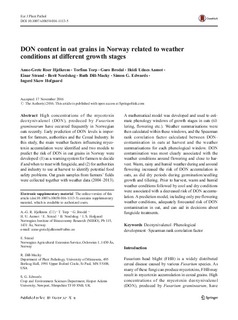| dc.contributor.author | Roer, Anne-Grete | |
| dc.contributor.author | Torp, Torfinn | |
| dc.contributor.author | Brodal, Guro | |
| dc.contributor.author | Aamot, Heidi | |
| dc.contributor.author | Strand, Einar | |
| dc.contributor.author | Nordskog, Berit | |
| dc.contributor.author | Dill-Macky, Ruth | |
| dc.contributor.author | Edwards, Simon G. | |
| dc.contributor.author | Hofgaard, Ingerd Skow | |
| dc.date.accessioned | 2016-12-06T11:25:55Z | |
| dc.date.available | 2016-12-06T11:25:55Z | |
| dc.date.created | 2016-12-05T20:38:55Z | |
| dc.date.issued | 2016-12 | |
| dc.identifier.citation | European journal of plant pathology. 2016. | nb_NO |
| dc.identifier.issn | 0929-1873 | |
| dc.identifier.uri | http://hdl.handle.net/11250/2424330 | |
| dc.description.abstract | High concentrations of the mycotoxin deoxynivalenol (DON), produced by Fusarium graminearum have occurred frequently in Norwegian oats recently. Early prediction of DON levels is important for farmers, authorities and the Cereal Industry. In this study, the main weather factors influencing mycotoxin accumulation were identified and two models to predict the risk of DON in oat grains in Norway were developed: (1) as a warning system for farmers to decide if and when to treat with fungicide, and (2) for authorities and industry to use at harvest to identify potential food safety problems. Oat grain samples from farmers’ fields were collected together with weather data (2004–2013). A mathematical model was developed and used to estimate phenology windows of growth stages in oats (tillering, flowering etc.). Weather summarisations were then calculated within these windows, and the Spearman rank correlation factor calculated between DON-contamination in oats at harvest and the weather summarisations for each phenological window. DON contamination was most clearly associated with the weather conditions around flowering and close to harvest. Warm, rainy and humid weather during and around flowering increased the risk of DON accumulation in oats, as did dry periods during germination/seedling growth and tillering. Prior to harvest, warm and humid weather conditions followed by cool and dry conditions were associated with a decreased risk of DON accumulation. A prediction model, including only pre-flowering weather conditions, adequately forecasted risk of DON contamination in oat, and can aid in decisions about fungicide treatments. | nb_NO |
| dc.language.iso | eng | nb_NO |
| dc.rights | Attribution-NoDerivatives 4.0 Internasjonal | * |
| dc.rights.uri | http://creativecommons.org/licenses/by-nd/4.0/deed.no | * |
| dc.title | DON content in oat grains in Norway related to weather conditions at different growth stages | nb_NO |
| dc.type | Journal article | nb_NO |
| dc.type | Peer reviewed | nb_NO |
| dc.rights.holder | © The Author(s) 2016 Open Access This article is distributed under the terms of the Creative Commons Attribution 4.0 International License (http://creativecommons.org/licenses/by/4.0/), which permits unrestricted use, distribution, and reproduction in any medium, provided you give appropriate credit to the original author(s) and the source, provide a link to the Creative Commons license, and indicate if changes were made. | nb_NO |
| dc.source.pagenumber | 18 | nb_NO |
| dc.source.journal | European journal of plant pathology | nb_NO |
| dc.identifier.doi | 10.1007/s10658-016-1113-5 | |
| dc.identifier.cristin | 1408661 | |
| cristin.ispublished | true | |
| cristin.fulltext | original | |
| cristin.qualitycode | 1 | |

